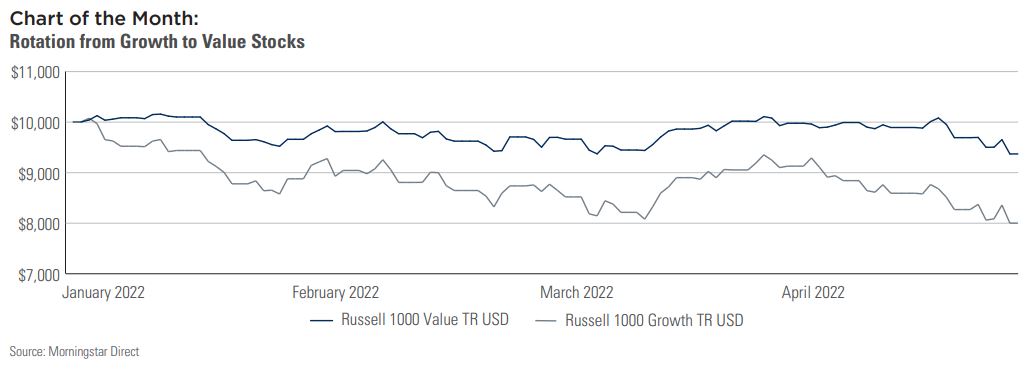Monthly Market Snapshot – May
After delivering a modest recovery from the lows of early March, equity markets experienced a resurgence in volatility and most of the major indices we follow saw material losses in April. The minutes from the Federal Reserve’s March meeting indicated a more aggressive-than expected stance towards the approach to monetary tightening and hinted at a 50-basis point hike in May, triggering a risk-off sentiment. Putin’s pessimism towards ongoing negotiations with Ukraine and rigid lockdown measures in China exacerbated supply chain issues and only worked to pressure capital markets. For the second half of April, Q1 earnings results were in focus as investors assessed how companies fared against rising inflationary pressures. After mixed earnings results from mega-cap FAANG names, stocks slid to end April, with the Nasdaq sliding 13% to mark its worst month since October 2008.
Canada’s benchmark S&P/TSX Composite Index was 5.2% lower in April, as nine of the benchmark’s underlying sectors were negative during the month. The decline was led by information technology and health care names, with losses of 19.9% and 17.8%, respectively. Only the energy sector managed to eke out a gain. There, stocks jumped 2.7%. Small cap stocks, as measured by the S&P/TSX Small Cap Index, slid 6.5% in April.
The U.S. dollar depreciated by 2.8% versus the loonie during the month, dampening the returns of foreign markets from a Canadian investor’s standpoint. Note that all returns in this paragraph are in CAD terms. U.S.-based stocks, as measured by the S&P 500 index, declined 6.3% in April. The telecommunication services and consumer discretionary sector’s saw the month’s steepest declines, falling 13.5% and 10.7%, respectively. The consumer staples and energy sectors were the only areas to manage gains, rising 5.2% and 1.0%, respectively. International stocks, as measured by the MSCI EAFE index, also lost 4.3% during the period, while emerging markets stocks fell 3.2%.
The investment grade fixed income indices we follow continued were in the red again in April. Canadian investment grade bonds, as measured by the FTSE Canada Universe Bond Index, lost 2.2% for the month while the key global investment grade bond benchmark fell by 5.5%. Global highyield issues lost 3.9%.
Turning to commodities, natural gas rallied 28.4% during the month, while the price of a barrel of crude oil gained 4.4%. On
the other hand, copper, silver and gold were in the red, with respective losses of 7.5%, 8.3% and 1.9%.
Inflation in Canada accelerated to 6.7% year-over-year in March, the highest print since 1991. The biggest contributor to the leap in inflation was transportation, largely due to surging prices for gasoline. The Canadian economy added 72,500 jobs in March, as the nation’s unemployment rate fell to 5.3% – the first time the rate fell to its pre-pandemic level. The Bank of Canada raised interest rates in April by half a percentage point to 1%, marking the first time for an increase of that magnitude since 2000.
U.S. nonfarm payrolls grew by 431,000 in March, as the unemployment rate declined to 3.6%. The consumer price index stayed elevated, jumping 8.5% year-over-year in March, and marking the highest level since 1981. Gasoline, shelter and groceries were again the major contributors to rising inflation. U.S. retail sales in March rose 0.5%. To combat record-high inflation, the U.S. Federal Reserve is expected to deliver two back-to-back half-point interest rate increases in May and June.
Content sourced from Bloomberg; data as at April 29, 2022.

Posted In: Market Updates

